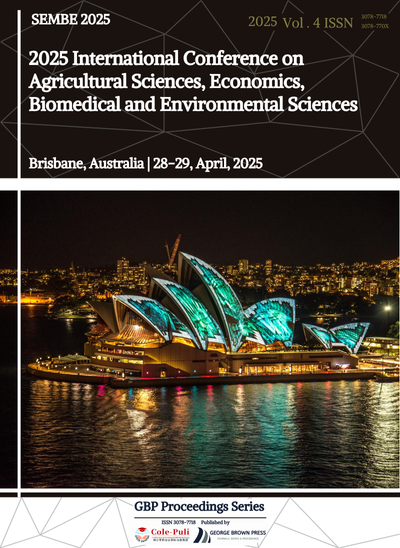Advances in Deficit-Regulated Irrigated Potato Research
DOI:
https://doi.org/10.71222/xqf7ns62Keywords:
potato, deficit irrigation, yield, quality, soil temperatureAbstract
Potato is one of the most important food crops worldwide, and its yield and quality are directly affected by irrigation management. Loss-in-adjustment irrigation is a water-saving and efficient irrigation strategy, which stimulates plant root development and improves water use efficiency by reducing the amount of irrigation during specific periods of the crop growth cycle, thus realizing the purpose of saving water and increasing yields. The purpose of this paper is to summarize the research progress on deficit-regulated irrigation in potato in recent years, to explore its impact on potato growth and development, yield formation, and quality enhancement, and to suggest potential avenues for future research.
References
1. W. Song et al., “Mulching practices improve soil moisture and enzyme activity in drylands, increasing potato yield,” Agronomy, vol. 14, no. 5, p. 1077, 2024, doi: 10.3390/agronomy14051077.
2. A. J. Haverkort and J. L. Top, “The potato ontology: delimitation of the domain, modelling concepts, and prospects of per-formance,” Potato Res., vol. 54, pp. 119–136, 2011, doi: 10.1007/s11540-010-9184-8.
3. G. Mahendiran, S. Lal, and O. C. Sharma, “Pests and their management on temperate fruits: (apple, pear, peach, apricot, cherry, persimmon, walnut, olive, kiwifruit and strawberry),” in Trends in Horticultural Entomology, 2022, pp. 891–941. ISBN: 978-981-19-0342-7.
4. J. Xue et al., “Water saving practices enhance regional efficiency of water consumption and water productivity in an arid ag-ricultural area with shallow groundwater,” Agric. Water Manag., vol. 194, pp. 78–89, 2017, doi: 10.1016/j.agwat.2017.09.003.
5. A. K. Choudhary and M. K. Hazarika, “Modelling and thermal analysis of an integrated solar greenhouse dryer for ginger (Zingiber officinale) and product quality,” J. Stored Prod. Res., vol. 106, p. 102313, 2024, doi: 10.1016/j.jspr.2024.102313.
6. M. R. Hadi, R. Taheri, and G. R. Balali, “Effects of iron and zinc fertilizers on the accumulation of Fe and Zn ions in potato tubers,” J. Plant Nutr., vol. 38, no. 2, pp. 202–211, 2015, doi: 10.1080/01904167.2014.934465.
7. X. Hou, R. Li, W. He, and K. Ma, “Effects of planting density on potato growth, yield, and water use efficiency during years with variable rainfall on the Loess Plateau, China,” Agric. Water Manag., vol. 230, p. 105982, 2020, doi: 10.1016/j.agwat.2019.105982.
8. Y. Li et al., “Effects of water–nitrogen coupling on root distribution and yield of summer maize at different growth stages,” Plants, vol. 14, no. 9, p. 1278, 2025, doi: 10.3390/plants14091278.
9. Y. Wang, S. Yu, and H. Zhang, “Review of study on the effects of regulated deficit irrigation on potato yield, quality, and water use efficiency,” in Water Conservancy and Civil Construction, vol. 1, pp. 154–158, 2023. ISBN: 9781003450818.
10. Q. Chen et al., “Straw return with biodegradable film mulch: a synergistic cultivation measure with environmental and eco-nomic benefits based on life cycle assessment,” Agronomy, vol. 14, no. 12, p. 2993, 2024, doi: 10.3390/agronomy14122993.
11. Y. Ding, X. Gao, Z. Qu, Y. Jia, M. Hu, and C. Li, “Effects of biochar application and irrigation methods on soil temperature in farmland,” Water, vol. 11, no. 3, p. 499, 2019, doi: 10.3390/w11030499.
12. X. Ye et al., “Impacts of irrigation methods on greenhouse gas emissions/absorptions from vegetable soils,” J. Soils Sediments, vol. 20, pp. 723–733, 2020, doi: 10.1007/s11368-019-02422-3.
13. H. Zhang, X. U. Fen, W. U. Yu, H. Hu, and X.-F. Dai, “Progress of potato staple food research and industry development in China,” J. Integr. Agric., vol. 16, no. 12, pp. 2924–2932, 2017, doi: 10.1016/S2095-3119(17)61736-2.
14. Z. Zhao et al., “Spatiotemporal variation in the coupling relationship between human activities and soil erosion—A case study in the Weihe River Basin,” Sustainability, vol. 15, no. 14, p. 10785, 2023, doi: 10.3390/su151410785.
15. Y. Wang, L. Ran, N. Fang, and Z. Shi, “Aggregate stability and associated organic carbon and nitrogen as affected by soil ero-sion and vegetation rehabilitation on the Loess Plateau,” Catena, vol. 167, pp. 257–265, 2018, doi: 10.1016/j.catena.2018.05.005.
16. Z. Shao et al., “Synthetic fertilizer application coupled with bioslurry optimizes potato (Solanum tuberosum) growth and yield,” Agronomy, vol. 13, no. 8, p. 2162, 2023, doi: 10.3390/agronomy13082162.
17. Z. Ferdous, H. Ullah, A. Datta, M. Anwar, and A. Ali, “Yield and profitability of tomato as influenced by integrated application of synthetic fertilizer and biogas slurry,” Int. J. Veg. Sci., vol. 24, no. 5, pp. 445–455, 2018, doi: 10.1080/19315260.2018.1434585.











